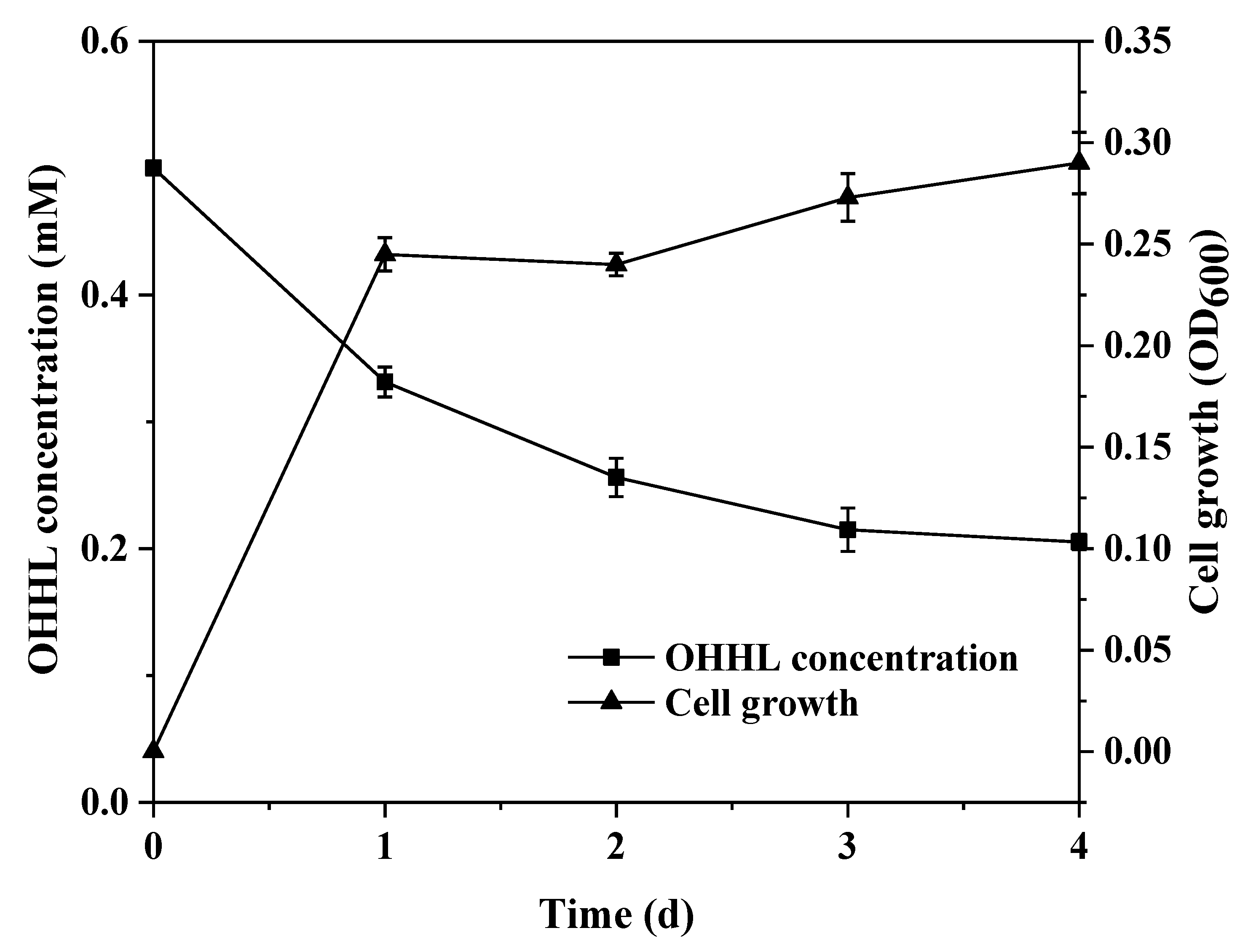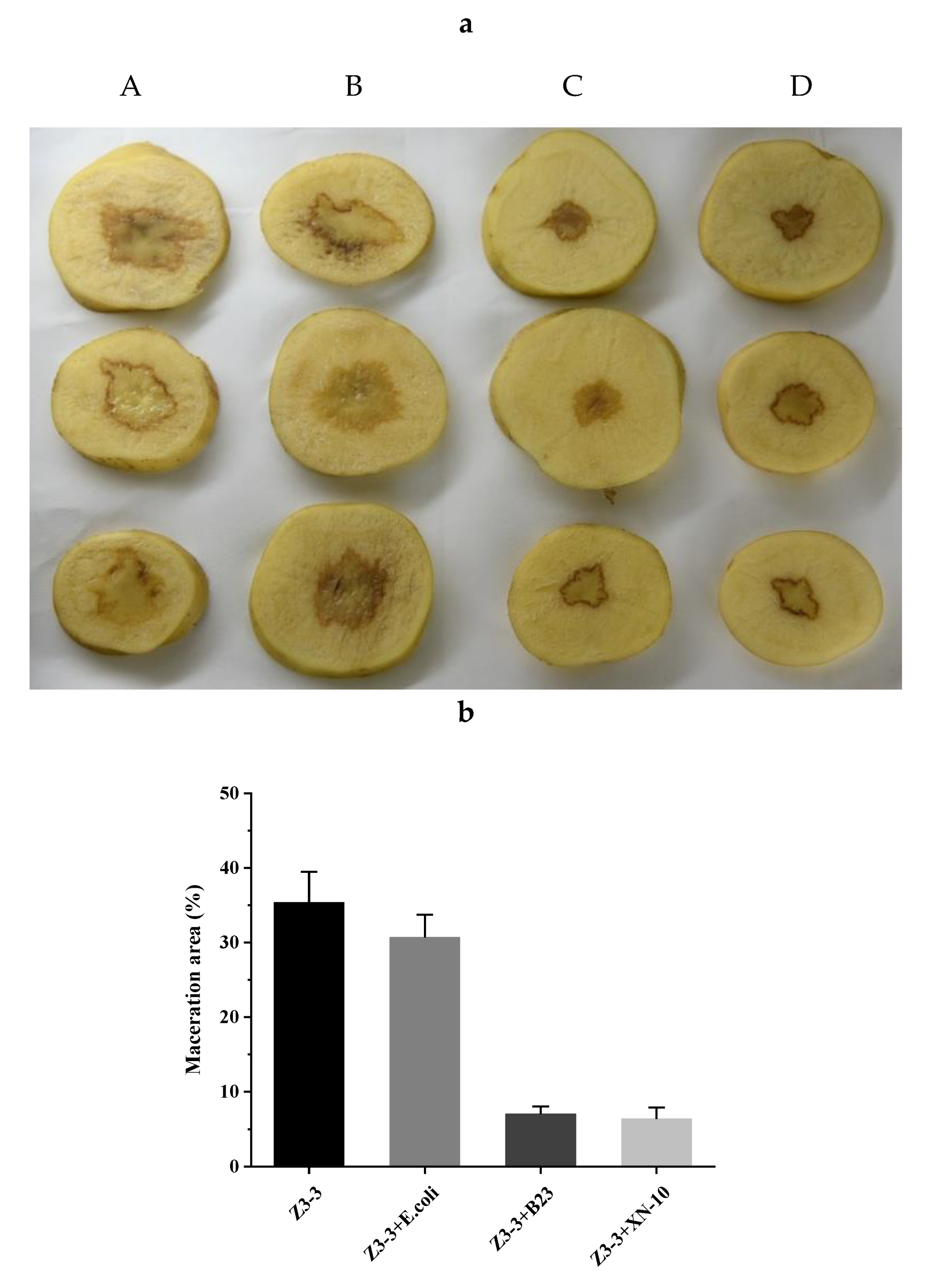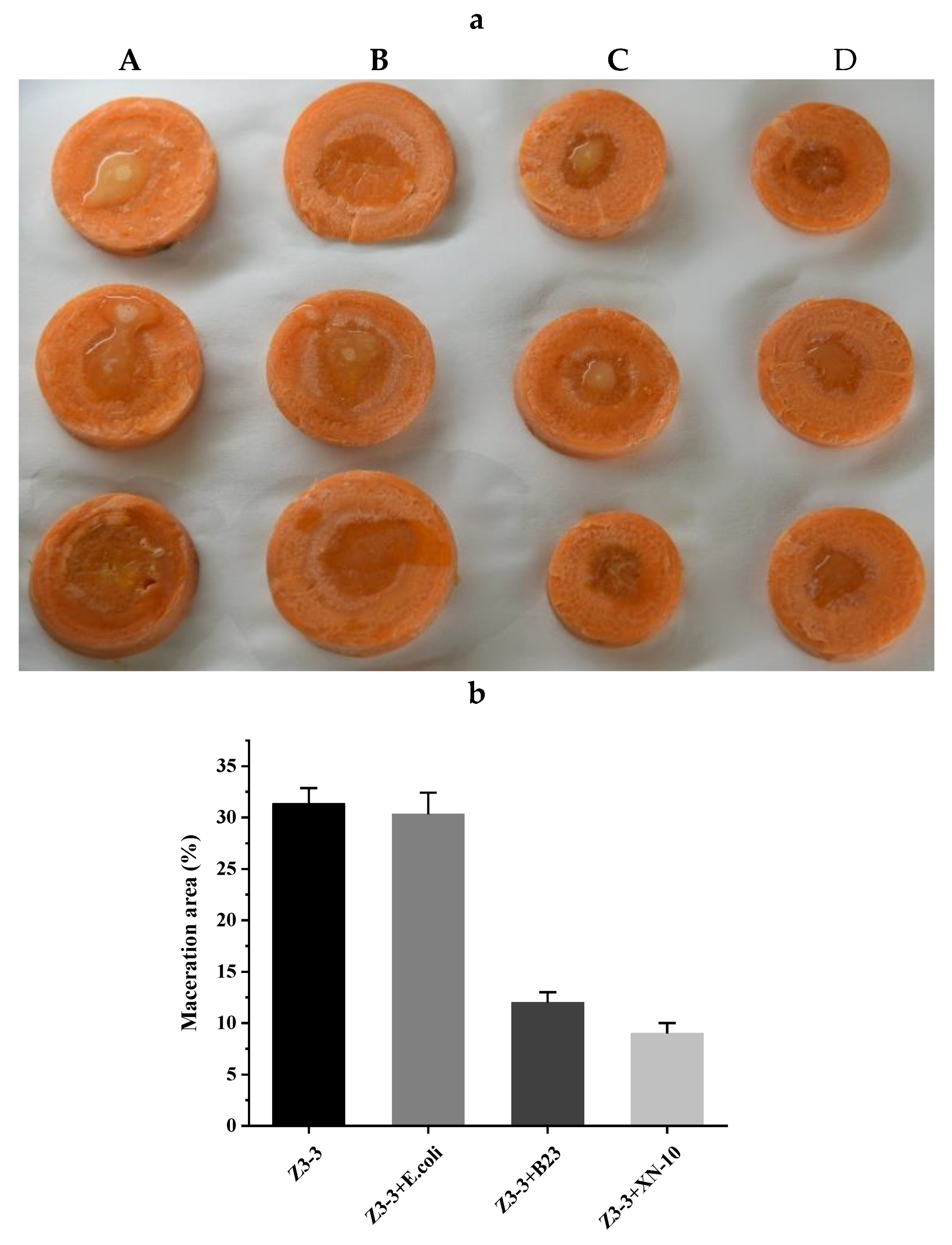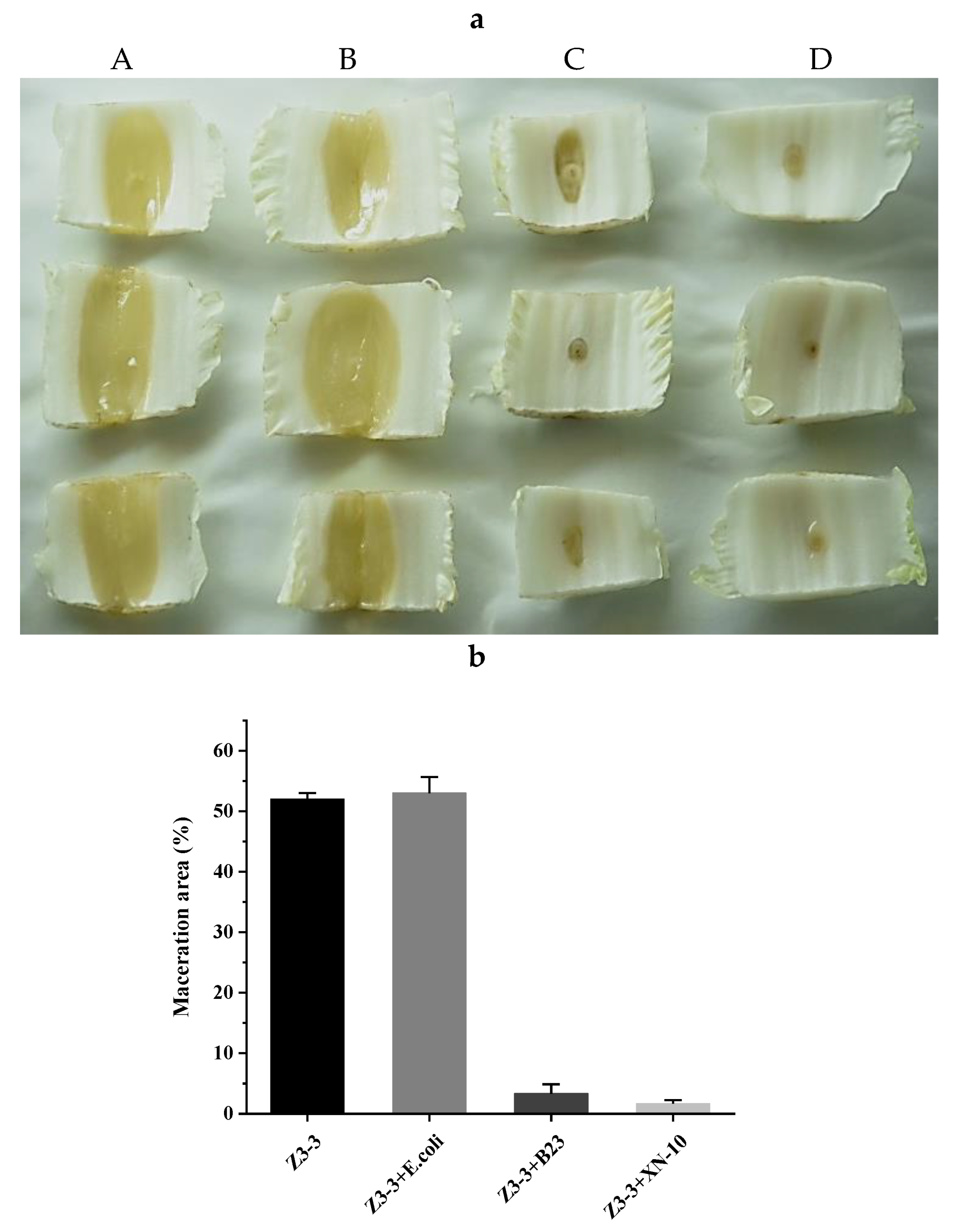Quorum Quenching in a Novel Acinetobacter sp. XN-10 Bacterial Strain against Pectobacterium carotovorum subsp. carotovorum
Abstract
:1. Introduction
2. Materials and Methods
2.1. Chemicals and Plants
2.2. Bacterial Strains and Media
2.3. Isolation and Screening of AHL-Degrading Bacteria
2.4. Identification and Antimicrobial Susceptibility of QQ Strains
2.5. AHL Degradation Assay
2.6. In Vitro Assay of Strain XN-10 against Pcc
2.7. Identification of AHL Metabolic Products
2.8. Statistical Analysis
3. Results
3.1. Screening, Identification, and Antimicrobial Susceptibility of AHL-Degrading Strains
3.2. AHL Degradation Abilities of Strain XN-10
3.3. Potential Use of Strain XN-10 against Pcc Infections
3.4. Metabolic Products and Degradation Pathway of AHL
4. Discussion
5. Conclusions
Supplementary Materials
Author Contributions
Funding
Conflicts of Interest
Abbreviations
| QS | quorum sensing |
| quorum quenching | |
| AHLs | N-acyl-homoserine lactones |
| OHHL | N-(3-oxohexanoyl)-L-homoserine lactone |
| C6HSL | N-hexanoyl-L-homoserine lactone |
| 3OC12HSL | N-(3-oxododecanoyl)-L-homoserine lactone |
| 3OC8HSL | N-(3-oxooctanoyl)-L-homoserine lactone |
| HPLC | high-performance liquid chromatography |
| GC-MS | gas chromatography–mass spectrometry |
| 3-OH-PAME | 3-hydroxypalmitic acid methyl ester |
| PQS | 2-heptyl-3-hydroxy-4(1H)-quinolone |
| AI-2 | autoinducer-2 |
| DSF | diffusible signal factor |
| IQS | 2-(2-hydroxyphenyl)-thiazole-4-carbaldehyde |
| Pel | pectate lyase |
| Pnl | pectin lyase |
| Peh | polygalacturonase |
| Cel | cellulase |
| Prt | protease |
| Amp | antibiotics ampicillin |
| Carb | carbenicillin |
| Str | streptomycin |
| TC | tetracycline |
| Gen | gentamicin |
| Cm | chloramphenicol |
| Kan | kanamycin |
| Neo | neomycin |
References
- Haque, M.M.; Oliver, M.M.H.; Kamrun, N.; Alam, M.Z.; Hirata, H.; Shinji, T. CytR homolog of Pectobacterium carotovorum subsp. carotovorum controls air-liquid biofilm formation by regulating multiple genes involved in cellulose production, c-di-GMP signaling, motility, and type III secretion system in response to nutritional and environmental signals. Front. Microbiol. 2017, 8, 972. [Google Scholar] [CrossRef] [PubMed] [Green Version]
- Davidsson, P.R.; Kariola, T.; Niemi, O.; Palva, E.T. Pathogenicity of and plant immunity to soft rot pectobacteria. Front. Plant Sci. 2013, 4, 191. [Google Scholar] [CrossRef] [PubMed] [Green Version]
- Dimas, M.S.; Sergio, A.O.; Cristian, N.D.; Daniel, T.O.; Manuel, L.M.; Rodolfo, T.A.; Samuel, R.A. Pectobacterium carotovorum subsp. brasiliense causes soft rot and death of Neobuxbaumia tetetzo in Zapotitlan Salinas Valley, Puebla, Mexico. Plant Dis. 2018, 103, 398–403. [Google Scholar] [CrossRef] [Green Version]
- Gao, B.; Wang, R.Y.; Chen, S.L.; Ma, J.; Li, X.H. First report of Pectobacterium carotovorum subsp. carotovorum and P. carotovorum subsp. odoriferum causing bacterial soft rot of sweetpotato in China. Plant Dis. 2016, 100, 1776. [Google Scholar] [CrossRef]
- Vasinauskiene, M.; Radusiene, J.; Zitikaite, I.; Surviliene, E. Antibacterial activities of essential oils from aromatic and medicinal plants against growth of phytopathogenic bacteria. Agron. Res. 2006, 4, 437–440. [Google Scholar]
- Gracia-Garza, J.A.; Blom, T.J.; Brown, W.; Allen, W. Pre- and post-plant applications of copper-based compounds to control Erwinia soft rot of Calla lilies. Can. J. Plant Pathol. 2002, 24, 274–280. [Google Scholar] [CrossRef]
- Jess, S.; Kildea, S.; Moody, A.; Rennick, G.; Murchie, A.K.; Cooke, L.R. European union policy on pesticides: Implications for agriculture in Ireland. Pest Manag. Sci. 2014, 70, 1646–1654. [Google Scholar] [CrossRef]
- Etminani, F.; Harighi, B. Isolation and Identification of endophytic bacteria with plant growth promoting activity and biocontrol potential from wild Pistachio trees. Plant Pathol. J. 2018, 34, 208–217. [Google Scholar] [CrossRef]
- Zhao, J.; Li, X.Y.; Hou, X.Y.; Quan, C.S.; Chen, M. Widespread existence of quorum sensing inhibitors in marine bacteria: Potential drugs to combat pathogens with novel strategies. Mar. Drugs 2019, 17, 275. [Google Scholar] [CrossRef] [Green Version]
- Torres, M.; Rubio-Portillo, E.; Antón, J.; Ramos-Esplá, A.A.; Quesada, E.; Llamas, I. Selection of the N-acylhomoserine lactone-degrading bacterium Alteromonas stellipolaris PQQ-42 and of its potential for biocontrol in aquaculture. Front. Microbiol. 2016, 7, 646. [Google Scholar] [CrossRef] [Green Version]
- Whiteley, M.; Diggle, S.P.; Greenberg, E.P. Progress in and promise of bacterial quorum sensing research. Nature 2017, 551, 313–320. [Google Scholar] [CrossRef] [PubMed]
- Engebrecht, J.; Silverman, M. Identification of genes and gene products necessary for bacterial bioluminescence. Proc. Natl. Acad. Sci. USA 1984, 81, 4154–4158. [Google Scholar] [CrossRef] [PubMed] [Green Version]
- Flavier, A.B.; Clough, S.J.; Schell, M.A.; Denny, T.P. Identification of 3-hydroxypalmitic acid methyl ester as a novel autoregulator controlling virulence in Ralstonia solanacearum. Mol. Microbiol. 1997, 26, 251–259. [Google Scholar] [CrossRef] [PubMed]
- Pesci, E.C.; Milbank, J.B.J.; Pearson, J.P.; McKnight, S.; Kende, A.S.; Greenberg, E.P.; lglewski, B.H. Quinolone signaling in the cell-to-cell communication system of Pseudomonas aeruginosa. Proc. Natl. Acad. Sci. USA 1999, 96, 11229–11234. [Google Scholar] [CrossRef] [PubMed] [Green Version]
- Chen, X.; Schauder, S.; Potier, N.; Van Dorsselaer, A.; Pelczer, I.; Bassler, B.L.; Hughson, F.M. Structural identification of a bacterial quorum-sensing signal containing boron. Nature 2002, 415, 545–549. [Google Scholar] [CrossRef]
- Wang, L.H.; He, Y.W.; Gao, Y.F.; Wu, J.E.; Dong, Y.H.; He, C.Z.; Wang, S.X.; Weng, L.X.; Xu, J.L.; Tay, L.; et al. A bacterial cell-cell communication signal with cross-kingdom structural analogues. Mol. Microbiol. 2004, 51, 903–912. [Google Scholar] [CrossRef]
- Lee, J.; Wu, J.; Deng, Y.Y.; Wang, J.; Wang, C.; Wang, J.H.; Chang, C.Q.; Dong, Y.H.; Williams, P.; Zhang, L.H.; et al. A cell-cell communication signal integrates quorum sensing and stress response. Nat. Chem. Biol. 2013, 9, 339. [Google Scholar] [CrossRef]
- LaSarre, B.; Federle, M.J. Exploiting quorum sensing to confuse bacterial pathogens. Microbiol. Mol. Biol. Rev. 2013, 77, 73–111. [Google Scholar] [CrossRef] [Green Version]
- Du, Y.F.; Li, T.; Wan, Y.F.; Long, Q.X.; Liao, P. Signal molecule-dependent quorum-sensing and quorum-quenching enzymes in bacteria. Crit. Rev. Eukaryot. Gene Expr. 2014, 24, 117–132. [Google Scholar] [CrossRef]
- Mansfield, J.; Genin, S.; Magori, S.; Citovsky, V.; Sriariyanum, M.; Ronald, P.; Dow, M.; Verdier, V.; Beer, S.V.; Machado, M.A.; et al. Top 10 plant pathogenic bacteria in molecular plant pathology. Mol. Plant Pathol. 2012, 13, 614–629. [Google Scholar] [CrossRef] [Green Version]
- Morohoshi, T.; Ogasawara, Y.; Xie, X.; Hamamoto, H.; Someya, N. Genetic and biochemical diversity for N-acylhomoserine lactone biosynthesis in the plant pathogen Pectobacterium carotovorum subsp. carotovorum. Microbes Environ. 2019, 34, 429–435. [Google Scholar] [CrossRef] [PubMed]
- Joshi, J.R.; Burdman, S.; Lipsky, A.; Yariv, S.; Yedidia, I. Plant phenolic acids affect the virulence of Pectobacterium aroidearum and P. carotovorum subsp. brasiliense via quorum sensing regulation. Mol. Plant Pathol. 2016, 17, 487–500. [Google Scholar] [CrossRef] [PubMed] [Green Version]
- Andersson, R.A.; Eriksson, A.R.B.; Heikinheimo, R.; Mae, A.; Pirhonen, M.; Koiv, V.; Hyytiainen, H.; Tuikkala, A.; Palva, E.T. Quorum sensing in the plant pathogen Erwinia carotovora subsp. carotovora: The role of expR(Ecc). Mol. Plant Microbe Interact. 2000, 13, 384–393. [Google Scholar] [CrossRef] [Green Version]
- Grandclement, C.; Tannieres, M.; Morera, S.; Dessaux, Y.; Faure, D. Quorum quenching: Role in nature and applied developments. FEMS Microbiol. Rev. 2016, 40, 86–116. [Google Scholar] [CrossRef] [PubMed]
- Chen, F.; Gao, Y.; Chen, X.; Yu, Z.; Li, X. Quorum quenching enzymes and their application in degrading signal molecules to block quorum sensing-dependent infection. Int. J. Mol. Sci. 2013, 14, 17477–17500. [Google Scholar] [CrossRef] [PubMed]
- Defoirdt, T.; Boon, N.; Bossier, P.; Verstraete, W. Disruption of bacterial quorum sensing: An unexplored strategy to fight infections in aquaculture. Aquaculture 2004, 240, 69–88. [Google Scholar] [CrossRef]
- Lade, H.; Paul, D.; Kweon, J.H. Quorum quenching mediated approaches for control of membrane biofouling. Int. J. Biol. Sci. 2014, 10, 547–562. [Google Scholar] [CrossRef]
- Fan, X.; Ye, T.; Li, Q.; Bhatt, P.; Zhang, L.; Chen, S. Potential of a quorum quenching bacteria isolate Ochrobactrum intermedium D-2 against soft rot pathogen Pectobacterium carotovorum subsp. carotovorum. Front. Microbiol. 2020, 11, 898. [Google Scholar] [CrossRef]
- Garge, S.S.; Nerurkar, A.S. Attenuation of quorum sensing regulated virulence of Pectobacterium carotovorum subsp. carotovorum through an AHL lactonase produced by Lysinibacillus sp. Gs50. PLoS ONE 2016, 11, e0167344. [Google Scholar] [CrossRef]
- Bhatt, P.; Rene, E.R.; Kumar, A.J.; Zhang, W.; Chen, S. Binding interaction of allethrin with esterase: Bioremediation potential and mechanism. Bioresour. Technol. 2020, 315, 123845. [Google Scholar] [CrossRef]
- Zhang, J.W.; Xuan, C.G.; Lu, C.H.; Guo, S.; Yu, J.F.; Asif, M.; Jiang, W.J.; Zhou, Z.G.; Luo, Z.Q.; Zhang, L.Q.; et al. AidB, a novel thermostable N-acylhomoserine lactonase from the bacterium Bosea sp. Appl. Environ. Microbiol. 2019, 85. [Google Scholar] [CrossRef] [PubMed]
- Tang, K.H.; Zhang, Y.H.; Yu, M.; Shi, X.C.; Coenye, T.; Bossier, P.; Zhang, X.H. Evaluation of a new high-throughput method for identifying quorum quenching bacteria. Sci. Rep. 2013, 3, 2935. [Google Scholar] [CrossRef] [PubMed] [Green Version]
- Bhatt, P.; Huang, Y.; Rene, E.R.; Kumar, A.J.; Chen, S. Mechanism of allethrin biodegradation by a newly isolated Sphingomonas trueperi strain CW3 from wastewater sludge. Bioresour. Technol. 2020, 305, 123074. [Google Scholar] [CrossRef] [PubMed]
- Deng, Y.; Lim, A.; Wang, J.; Zhou, T.; Chen, S.; Lee, J.; Dong, Y.H.; Zhang, L.H. Cis-2-dodecenoic acid quorum sensing system modulates N-acyl homoserine lactone production through RpfR and cyclic di-GMP turnover in Burkholderia cenocepacia. BMC Microbiol. 2013, 13, 148. [Google Scholar] [CrossRef] [PubMed] [Green Version]
- Wang, H.; Liao, L.; Chen, S.; Zhang, L. A quorum quenching bacterial isolate contains multiple substrate-inducible genes conferring degradation of diffusible signal factor. Appl. Environ. Microbiol. 2020, 86. [Google Scholar] [CrossRef]
- Bzdrenga, J.; Daude, D.; Remy, B.; Jacquet, P.; Plener, L.; Elias, M.; Chabriere, E. Biotechnological applications of quorum quenching enzymes. Chem. Biol. Interact. 2017, 267, 104–115. [Google Scholar] [CrossRef]
- Liu, S.; He, F.; Lin, N.; Chen, Y.; Liang, Z.; Liao, L.; Lv, M.; Chen, Y.; Chen, S.H.; Zhou, J.; et al. Pseudomonas sp. ST4 produces variety of active compounds to interfere fungal sexual mating and hyphal growth. Microb. Biotechnol. 2020, 13, 107–117. [Google Scholar] [CrossRef] [Green Version]
- Liu, S.; Lin, N.; Chen, Y.; Liang, Z.; Liao, L.; Lv, M.; Chen, Y.; Tang, Y.; He, F.; Chen, S.; et al. Biocontrol of sugarcane smut disease by interference of fungal sexual mating and hyphal growth using a bacterial isolate. Front. Microbiol. 2017, 8, 778. [Google Scholar] [CrossRef]
- Reina, J.C.; Torres, M.; Llamas, I. Stenotrophomonas maltophilia AHL-degrading strains isolated from marine invertebrate microbiota attenuate the virulence of Pectobacterium carotovorum and Vibrio coralliilyticus. Mar. Biotechnol. 2019, 21, 276–290. [Google Scholar] [CrossRef]
- Delshad, S.T.; Soltanian, S.; Sharifiyazdi, H.; Haghkhah, M.; Bossier, P. Identification of N-acyl homoserine lactone-degrading bacteria isolated from rainbow trout (Oncorhynchus mykiss). J. Appl. Microbiol. 2018, 125, 356–369. [Google Scholar] [CrossRef]
- Kusada, H.; Zhang, Y.; Tamaki, H.; Kimura, N.; Kamagata, Y. Novel N-acyl homoserine lactone-degrading bacteria isolated from penicillin-contaminated environments and their quorum-quenching activities. Front. Microbiol. 2019, 10, 455. [Google Scholar] [CrossRef] [PubMed] [Green Version]
- Cui, X.; Harling, R. N-acyl-homoserine lactone-mediated quorum sensing blockage, a novel strategy for attenuating pathogenicity of Gram-negative bacterial plant pathogens. Eur. J. Plant Pathol. 2005, 111, 327–339. [Google Scholar] [CrossRef]
- Zhang, L.H. Quorum quenching and proactive host defense. Trends Plant Sci. 2003, 8, 238–244. [Google Scholar] [CrossRef]
- Bhatt, P.; Verma, A.; Verma, S.; Anwar, M.S.; Prasher, P.; Mudila, H.; Chen, S. Understanding phytomicrobiome: A potential reservoir for better crop management. Sustainability 2020, 12, 5446. [Google Scholar] [CrossRef]
- Ye, T.; Zhou, T.; Li, Q.; Xu, X.; Fan, X.; Zhang, L.; Chen, S. Cupriavidus sp. HN-2, a novel quorum quenching bacterial isolate, is a potent biocontrol agent against Xanthomonas campestris pv. campestris. Microorganisms 2020, 8, 45. [Google Scholar] [CrossRef] [PubMed] [Green Version]
- Rasmussen, T.B.; Bjarnsholt, T.; Skindersoe, M.E.; Hentzer, M.; Kristoffersen, P.; Kote, M.; Nielsen, J.; Eberl, L.; Givskov, M. Screening for quorum-sensing inhibitors (QSI) by use of a novel genetic system, the QSI selector. J. Bacteriol. 2005, 187, 1799–1814. [Google Scholar] [CrossRef] [PubMed] [Green Version]
- Deng, Y.; Liu, X.; Wu, J.; Lee, J.; Chen, S.; Cheng, Y.; Zhang, C.; Zhang, L. The host-plant metabolite glucose is the precursor of diffusible signal factor DSF family signals in Xanthomonas campestris. Appl. Environ. Microbiol. 2015, 81, 2861–2868. [Google Scholar] [CrossRef] [Green Version]
- Ohta, T.; Fukumoto, A.; Iizaka, Y.; Kato, F.; Koyama, Y.; Anzai, Y. Quorum sensing inhibitors against Chromobacterium violaceum CV026 derived from an actinomycete metabolite library. Biol. Pharm. Bull. 2020, 43, 179–183. [Google Scholar] [CrossRef] [Green Version]
- Ye, T.; Zhou, T.; Fan, X.; Bhatt, P.; Zhang, L.H.; Chen, S. Acinetobacter lactucae strain QL-1, a novel quorum quenching candidate against bacterial pathogen Xanthomonas campestris pv. campestris. Front. Microbiol. 2019, 10, 2867. [Google Scholar] [CrossRef]
- Cui, T.Q.; Bai, F.L.; Sun, M.T.; Lv, X.R.; Li, X.P.; Zhang, D.F.; Du, H. Lactobacillus crustorum ZHG 2-1 as novel quorum-quenching bacteria reducing virulence factors and biofilms formation of Pseudomonas aeruginosa. LWT-Food Sci. Technol. 2019, 117, 108696. [Google Scholar] [CrossRef]
- Pan, Y.L.; Wang, Y.B.; Yan, X.Q.; Liu, C.H.; Wu, B.B.; He, X.P.; Liang, Y. Quorum quenching enzyme APTM01, an acyl homoserine-lactone acylase from marine bacterium of Pseudoalteromonas tetraodonis strain MQS005. Curr. Microbiol. 2019, 76, 1387–1397. [Google Scholar] [CrossRef] [PubMed]
- Murugayah, S.A.; Gerth, M.L. Engineering quorum quenching enzymes: Progress and perspectives. Biochem. Soc. Trans. 2019, 47, 793–800. [Google Scholar] [CrossRef] [PubMed]









© 2020 by the authors. Licensee MDPI, Basel, Switzerland. This article is an open access article distributed under the terms and conditions of the Creative Commons Attribution (CC BY) license (http://creativecommons.org/licenses/by/4.0/).
Share and Cite
Zhang, W.; Luo, Q.; Zhang, Y.; Fan, X.; Ye, T.; Mishra, S.; Bhatt, P.; Zhang, L.; Chen, S. Quorum Quenching in a Novel Acinetobacter sp. XN-10 Bacterial Strain against Pectobacterium carotovorum subsp. carotovorum. Microorganisms 2020, 8, 1100. https://doi.org/10.3390/microorganisms8081100
Zhang W, Luo Q, Zhang Y, Fan X, Ye T, Mishra S, Bhatt P, Zhang L, Chen S. Quorum Quenching in a Novel Acinetobacter sp. XN-10 Bacterial Strain against Pectobacterium carotovorum subsp. carotovorum. Microorganisms. 2020; 8(8):1100. https://doi.org/10.3390/microorganisms8081100
Chicago/Turabian StyleZhang, Wenping, Qingqing Luo, Yiyin Zhang, Xinghui Fan, Tian Ye, Sandhya Mishra, Pankaj Bhatt, Lianhui Zhang, and Shaohua Chen. 2020. "Quorum Quenching in a Novel Acinetobacter sp. XN-10 Bacterial Strain against Pectobacterium carotovorum subsp. carotovorum" Microorganisms 8, no. 8: 1100. https://doi.org/10.3390/microorganisms8081100
APA StyleZhang, W., Luo, Q., Zhang, Y., Fan, X., Ye, T., Mishra, S., Bhatt, P., Zhang, L., & Chen, S. (2020). Quorum Quenching in a Novel Acinetobacter sp. XN-10 Bacterial Strain against Pectobacterium carotovorum subsp. carotovorum. Microorganisms, 8(8), 1100. https://doi.org/10.3390/microorganisms8081100






